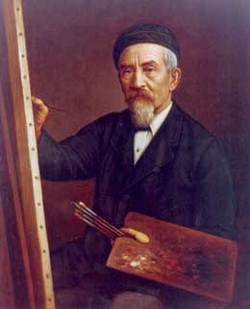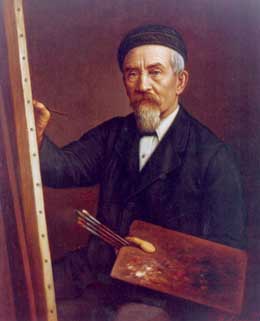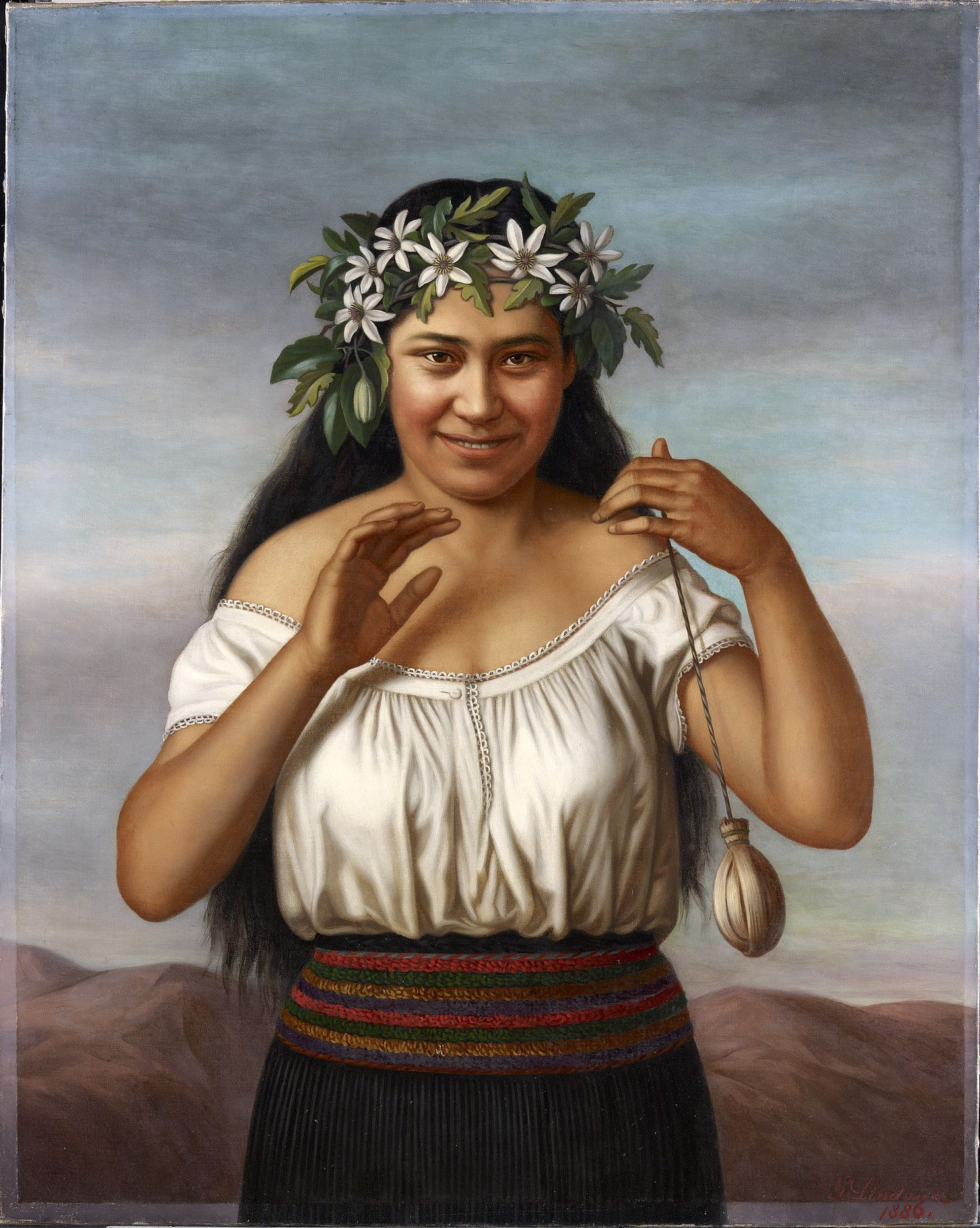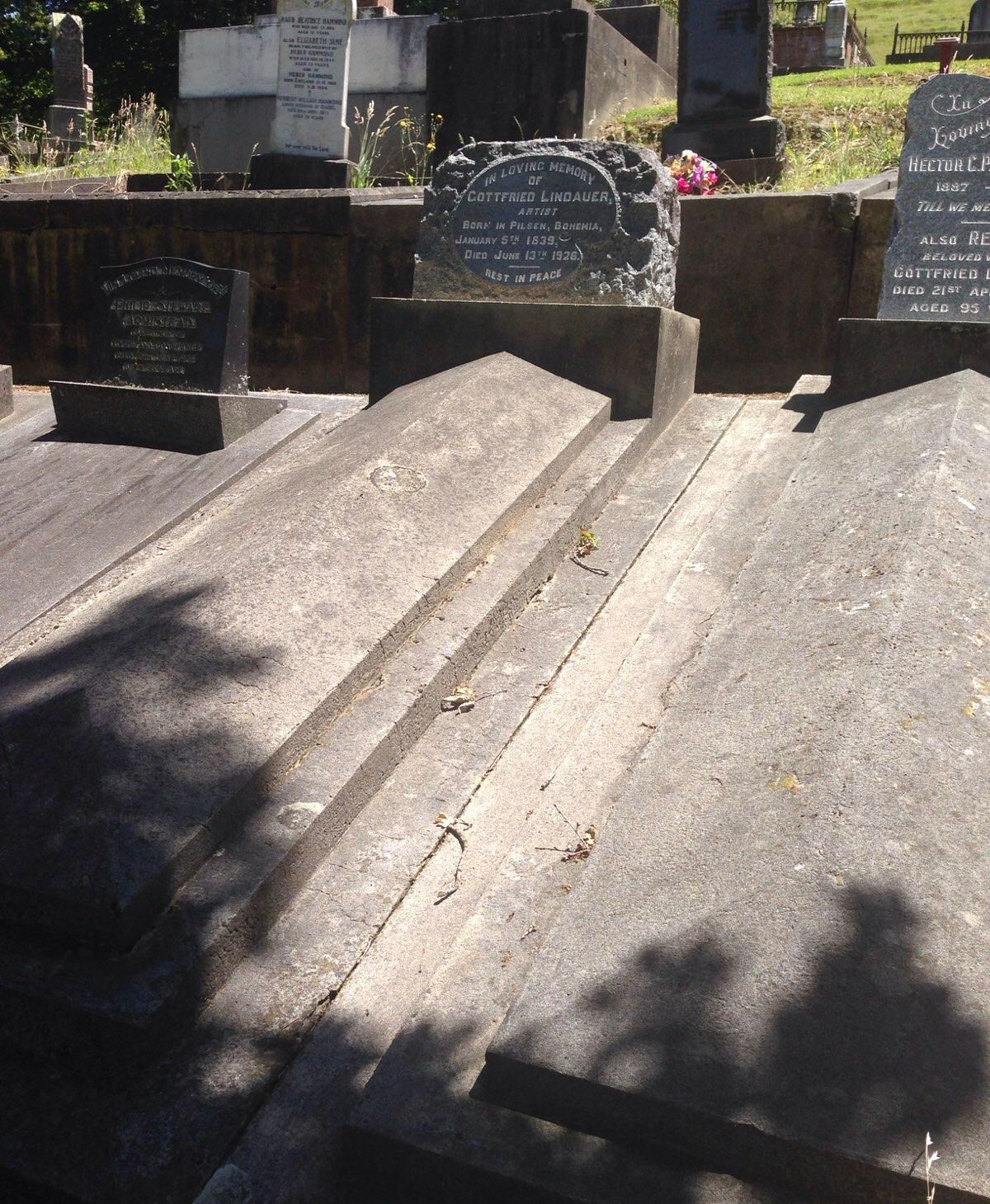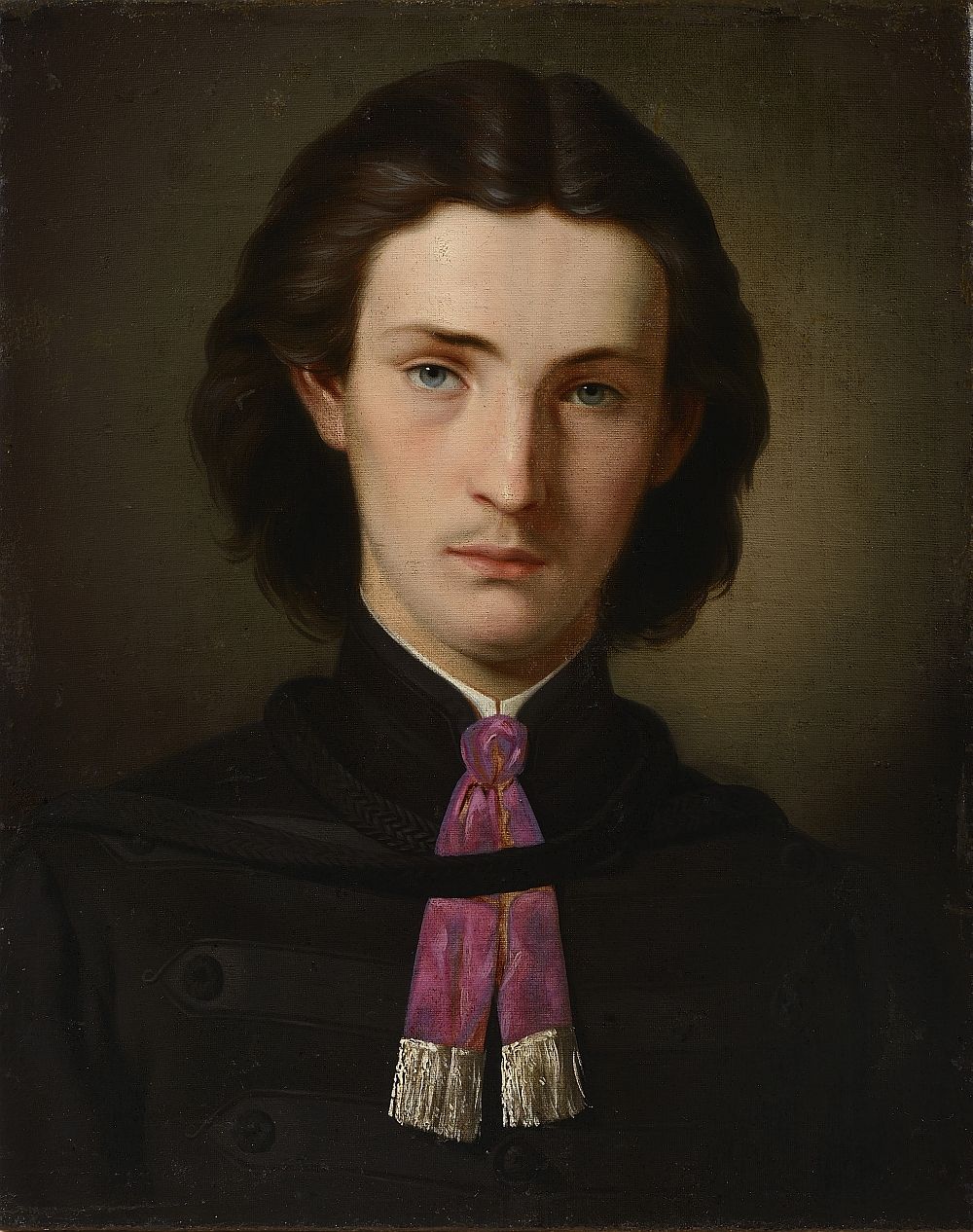Gottfried married twice
* He first married in 1879, in Melbourne, to Emelia Wipper (1853-1880). Emelia was born 1853 in Danzig Stadt, Westpreussen, Preussen. She arrived into Queensland as an assisted immigrant, on the Hamburg on 16 Oct 1878. She travelled down to Melbourne where she met Gottfried. They married there in 1879 and 6 months later returned in NZ to settle in Christchurch. Emelia died soon afterwards, on 24 Feb 1880 in childbirth
* It is said Emelia died in childbirth also that she died of peritonitis
Gottfried moved up to Napier in 1881 where he was naturalised and where he next married on 15 Sept 1885, to Rebecca Petty, of Bishop Stortford, England.
They had two sons
* 1887 - 1928 Hector Carnell Partridge Lindauer
. In 1911 Hector was a Student of Music, living in Woodville. In 1925 he was a Music Teacher living on Pinfold Road, Woodville. He is buried with his mother
* 1888 - 1964 Victor Wilhelm Lindauer
. headmaster and teacher at Russell. He married Elsie May Lovell in 1927, daughter of George Enoch Lovell & Annie Elizabeth Melhuish, of Woodville. He devoted 28 of his 75 years to the study of the marine algae of New Zealand
Taken from Encyclopedia of New Zealand
LINDAUER, Gottfried or Bohumir (1839–1926) Artist
Gottfried Lindauer was born on 5 January 1839 at Pilsen, Bohemia (now in Czechoslovakia), in the Austrian Empire. He was the son of Ignatz Lindauer, a nurseryman and Mary née Smith. His paternal uncle was Bishop of Budweis. For three years following his thirteenth birthday, young Lindauer was apprenticed in his father's nurseries and, while there, made many drawings and paintings of flowers. By the time his apprenticeship was completed he had decided to become an artist and in 1855 walked the 200 miles from Pilsen to enrol at the Vienna Academy of Arts. Lindauer remained at the Academy for the next seven years, studying portrait painting under Professors Fuerich and Kuppleweisser. In 1861 one of his professors arranged for him to join Hemerlein, who was then one of the best known Viennese painters of religious subjects. Hemerlein secured him a commission to paint religious motifs for the Church of SS. Cyril and Method at Valasske Klobouky, a small town in Moravia. Afterwards he returned to Pilsen where he set up his own studio. His work here was interrupted by the necessity to undergo military training; however, as the young artist showed no aptitude for soldiering, his commanding officer commissioned a portrait of his wife. Other officers followed suit and before long, he obtained commissions to paint portraits of many of the local notables.
Lindauer spent the next few years in Poland, giving private tuition in painting to the daughters of a Polish nobleman and in Russia, where he painted Biblical subjects for a number of Catholic Cathedrals. Early in 1873 he was again called for military service; but, having been influenced by the Czech nationalism of his day, he obtained a year's deferment and fled the country. From Hamburg, he took passage in the Reichstag and landed in Nelson in August 1873 . passenger list http://tinyurl.com/6u6r838p
Lindauer spent the next three years in the South Island. In 1876 he moved to Auckland, where he painted his first Maori portrait – that of Moses, a Maori peach hawker. In 1877 he held an exhibition in Wellington which drew much interest and led to many prominent Maori chiefs commissioning their portraits. Towards the end of the year he visited Thames, where he conceived the idea of painting a Maori scene to send to his native country. This picture – Woman and Child – attracted Sir Walter Buller's attention and led, eventually, to Buller's commissioning 20 Lindauer pictures for the London Intercolonial Exhibition in 1885. One of these, Poi Girl, was presented to the Prince of Wales.
In 1889 Lindauer took up a section in Pinfold Road, Woodville, Hawke's Bay, where he lived, with the exception of two brief visits to Europe, until his death. At Woodville he continued to paint portraits for people who came to him from all parts of New Zealand. It was here he completed the 70 Maori pictures for the H. E. Partridge Collection, Auckland. He continued to paint until eight years before his death. Lindauer died at Woodville on 13 June 1926.
Some confusion arises from Lindauer's mode of signing his pictures. Those painted in Europe are signed "B. Lindaur" or "B. Lindauer" – the "B." standing for his Czech Christian name "Bohumir", while the spelling of Lindauer was apparently optional. His pictures painted in New Zealand are signed "G. Lindauer" – the "G." standing for his German name "Gottfried", and the surname being spelt with an "e".
by Bernard John Foster, M.A., Research Officer, Department of Internal Affairs, Wellington .. Lindauer was an accomplished and meticulous draughtsman and his paintings present a faithful ethnological record. In depicting Maori garments, ornaments, and weapons, Lindauer has not been surpassed. His rendering of Maori features and moko (tattooing) are highly valued by ethnologists. He never permitted imagination to replace authenticity in recording the customs and the way of life of the Maori people of his day. As a result, his work lacks the romantic appeal of later artists, like C. F. Goldie or H. Linley Richardson, who searched out the fast-disappearing picturesque types, the relics of those "bygone" days already recorded by Lindauer.
Lindauer's paintings are valuable because either he was endowed with little inventive facility or he suppressed this quality in his paintings of the Maori. His compositions are obvious and even trite and his colour is truthful but never adventurous. He was a recorder with a fastidious eye for the factual. With ample technical skill to achieve his purpose, he could paint a replica or a number of replicas almost indistinguishable from the original painting from life. Partridge presented his collection of about 80 Lindauers to the citizens of Auckland during the First World War on condition that the city raised £10,000 for the Belgian Relief Fund. In a few weeks this amount was oversubscribed. The Partridge Collection is now housed in the Auckland City Art Gallery. There are also a number of fine Lindauers in the New Plymouth and in the Wanganui Museums.
Gottfried died in his sleep on Sunday morning at Woodville, survived by his widow and two sons.
NZ herald, 15 June 1926
DEATH of GOTTFRIED LINDAUER Painter of Noted Maoris
Information has been received by Mr H. E. Partridge of the death at Woodville in the 88th year of his age, of Herr Gottfried Lindauer, the noted painter of Maori portraits.
Herr Lindauer was born at Pilsen, Bohemia (Czecho-Slovakia) in 1839 and came to New Zealand 53 years ago. During his 30 years residence in New Zealand he painted from life more people of the Maori race than any other living man. Mr Henry Edward Partridge (1848-1931) engaged Herr Lindauer to paint the pictures, accompanied the artist to the homes of the Maori and arranged the sittings. This was the manner in which the Lindauer collection was formed, which later was presented to the citizens of Auckland by Mr Partridge and is now a feature of the Art Gallery.
There is nothing else quite like the striking canvases which perpetuate the features of some of the most famous rangatiras and fighting chiefs of the old school, At the present time there is not a single example of the high-caste tattooed Maori left and if the present generation wants to known what these fine old people were like, he will have to go to the Lindauer collection.
The fidelity of Lindauer's portraits is amply borne out by the friends and relatives of the men and women whose features he transferred to canvas. In addition to the very truthful portraits, Lindauer also preserved a number of the peculiar old customs of the native race, including the interesting ceremony of 'tapu' which is the subject of one of the most popular pictures in the collection. Owing to the wonderfully accurate drawing of the tattoo of the various sitters, the pictures have a special interest in preserving what is now a lost art.
Lindauer was born at Pilsen, Bohemia, Austria, on January 5, 1839. At the age of 16 he left Pilsen for Vienna to study portrait painting under Professors Fuehrich and Kuppelwieser. After seven years close study, Lindauer's work began to attract the attention of a great number of wealthy and prominent persons from whom, for several years, he received many valuable commissions. Later he was engaged to visit various parts of Austria, Moravia and Russia, painting Biblical subjects for a number of Catholic cathedrals, churches and eminent churchmen,
On completion of these commissions Herr Lindauer returned to Bohemia. WHile there he happened to read an article in one of the local journals giving a glowing account of the beauties of New Zealand and its native people, the Maori. The article appealed strongly to Lindauer's artistic instinct and in the early part of the year 1873 he sailed from Hamburg in the ship 'Reichstag' for Wellington, landing there in August of the same year. Immediately afterwards he began travelling through the native district of both islands of New Zealand, securing sittings from a great number of the most influential Maori chiefs and members of their families, many of whom figured prominently in the early history of the colony. It was during Herr Lindauer's first visit to Auckland, in the year 8174, that he and Mr H. E. Partridge met. From this meeting sprang the friendship which the succeeding years only helped to cement more securely.
It was at this first meeting, at which he inspected some of Lindauer's sketches, that the idea of making a collection of the portraits of these notable Maori people and illustrations of their old-time customs occurred to Mr Partridge. The result of the compact then made is now to be seen in the Auckland Art Gallery. Herr Lindauer had also painted portraits of a number of our foremost clerics and public men, among others the late Sir Walter Buller, who also gave him several commissions to paint the portraits of some of his Maori friends. It was at the opening of the India and Colonial Exhibition in London that our late King, then the Prince of Wales, became enamoured of one of the Maori subjects painted by Lindauer and exhibited by Buller. It was a picture of a Maori girl with clematis wreathed round her head. Buller, noticing the Princes's admiration sent the picture the next day to Marlborough House begging his acceptance of it.
No living artist had such splendid opportunities of painting the old-time Maori as Lindauer enjoyed. And the gallery which has been built of his pictures is a monument of artistic skill, industry and patience. No artist has equalled him in the truthful painting of the Maori in the nude. Particularly has he excelled in the painting of women and young children, whose flesh tints have been the despair of many an artist. And in no instance has a Maori ever pointed out a mistake in the technical make-up of the pictures - the patterns and colour of the tattooing, the flax and the feather garments, weapons, houses and all the multitudinous details in which errors might very easily be made by those who had not made a very long and close study of the native people in their own homes.
. NOTES .
43 of the 100s of Gottfried's Maori paintings .. https://tinyurl.com/224fu7tn
Another bio with links to paintings .. https://tinyurl.com/3zv9a5bw
Gottfried married twice
* He first married in 1879, in Melbourne, to Emelia Wipper (1853-1880). Emelia was born 1853 in Danzig Stadt, Westpreussen, Preussen. She arrived into Queensland as an assisted immigrant, on the Hamburg on 16 Oct 1878. She travelled down to Melbourne where she met Gottfried. They married there in 1879 and 6 months later returned in NZ to settle in Christchurch. Emelia died soon afterwards, on 24 Feb 1880 in childbirth
* It is said Emelia died in childbirth also that she died of peritonitis
Gottfried moved up to Napier in 1881 where he was naturalised and where he next married on 15 Sept 1885, to Rebecca Petty, of Bishop Stortford, England.
They had two sons
* 1887 - 1928 Hector Carnell Partridge Lindauer
. In 1911 Hector was a Student of Music, living in Woodville. In 1925 he was a Music Teacher living on Pinfold Road, Woodville. He is buried with his mother
* 1888 - 1964 Victor Wilhelm Lindauer
. headmaster and teacher at Russell. He married Elsie May Lovell in 1927, daughter of George Enoch Lovell & Annie Elizabeth Melhuish, of Woodville. He devoted 28 of his 75 years to the study of the marine algae of New Zealand
Taken from Encyclopedia of New Zealand
LINDAUER, Gottfried or Bohumir (1839–1926) Artist
Gottfried Lindauer was born on 5 January 1839 at Pilsen, Bohemia (now in Czechoslovakia), in the Austrian Empire. He was the son of Ignatz Lindauer, a nurseryman and Mary née Smith. His paternal uncle was Bishop of Budweis. For three years following his thirteenth birthday, young Lindauer was apprenticed in his father's nurseries and, while there, made many drawings and paintings of flowers. By the time his apprenticeship was completed he had decided to become an artist and in 1855 walked the 200 miles from Pilsen to enrol at the Vienna Academy of Arts. Lindauer remained at the Academy for the next seven years, studying portrait painting under Professors Fuerich and Kuppleweisser. In 1861 one of his professors arranged for him to join Hemerlein, who was then one of the best known Viennese painters of religious subjects. Hemerlein secured him a commission to paint religious motifs for the Church of SS. Cyril and Method at Valasske Klobouky, a small town in Moravia. Afterwards he returned to Pilsen where he set up his own studio. His work here was interrupted by the necessity to undergo military training; however, as the young artist showed no aptitude for soldiering, his commanding officer commissioned a portrait of his wife. Other officers followed suit and before long, he obtained commissions to paint portraits of many of the local notables.
Lindauer spent the next few years in Poland, giving private tuition in painting to the daughters of a Polish nobleman and in Russia, where he painted Biblical subjects for a number of Catholic Cathedrals. Early in 1873 he was again called for military service; but, having been influenced by the Czech nationalism of his day, he obtained a year's deferment and fled the country. From Hamburg, he took passage in the Reichstag and landed in Nelson in August 1873 . passenger list http://tinyurl.com/6u6r838p
Lindauer spent the next three years in the South Island. In 1876 he moved to Auckland, where he painted his first Maori portrait – that of Moses, a Maori peach hawker. In 1877 he held an exhibition in Wellington which drew much interest and led to many prominent Maori chiefs commissioning their portraits. Towards the end of the year he visited Thames, where he conceived the idea of painting a Maori scene to send to his native country. This picture – Woman and Child – attracted Sir Walter Buller's attention and led, eventually, to Buller's commissioning 20 Lindauer pictures for the London Intercolonial Exhibition in 1885. One of these, Poi Girl, was presented to the Prince of Wales.
In 1889 Lindauer took up a section in Pinfold Road, Woodville, Hawke's Bay, where he lived, with the exception of two brief visits to Europe, until his death. At Woodville he continued to paint portraits for people who came to him from all parts of New Zealand. It was here he completed the 70 Maori pictures for the H. E. Partridge Collection, Auckland. He continued to paint until eight years before his death. Lindauer died at Woodville on 13 June 1926.
Some confusion arises from Lindauer's mode of signing his pictures. Those painted in Europe are signed "B. Lindaur" or "B. Lindauer" – the "B." standing for his Czech Christian name "Bohumir", while the spelling of Lindauer was apparently optional. His pictures painted in New Zealand are signed "G. Lindauer" – the "G." standing for his German name "Gottfried", and the surname being spelt with an "e".
by Bernard John Foster, M.A., Research Officer, Department of Internal Affairs, Wellington .. Lindauer was an accomplished and meticulous draughtsman and his paintings present a faithful ethnological record. In depicting Maori garments, ornaments, and weapons, Lindauer has not been surpassed. His rendering of Maori features and moko (tattooing) are highly valued by ethnologists. He never permitted imagination to replace authenticity in recording the customs and the way of life of the Maori people of his day. As a result, his work lacks the romantic appeal of later artists, like C. F. Goldie or H. Linley Richardson, who searched out the fast-disappearing picturesque types, the relics of those "bygone" days already recorded by Lindauer.
Lindauer's paintings are valuable because either he was endowed with little inventive facility or he suppressed this quality in his paintings of the Maori. His compositions are obvious and even trite and his colour is truthful but never adventurous. He was a recorder with a fastidious eye for the factual. With ample technical skill to achieve his purpose, he could paint a replica or a number of replicas almost indistinguishable from the original painting from life. Partridge presented his collection of about 80 Lindauers to the citizens of Auckland during the First World War on condition that the city raised £10,000 for the Belgian Relief Fund. In a few weeks this amount was oversubscribed. The Partridge Collection is now housed in the Auckland City Art Gallery. There are also a number of fine Lindauers in the New Plymouth and in the Wanganui Museums.
Gottfried died in his sleep on Sunday morning at Woodville, survived by his widow and two sons.
NZ herald, 15 June 1926
DEATH of GOTTFRIED LINDAUER Painter of Noted Maoris
Information has been received by Mr H. E. Partridge of the death at Woodville in the 88th year of his age, of Herr Gottfried Lindauer, the noted painter of Maori portraits.
Herr Lindauer was born at Pilsen, Bohemia (Czecho-Slovakia) in 1839 and came to New Zealand 53 years ago. During his 30 years residence in New Zealand he painted from life more people of the Maori race than any other living man. Mr Henry Edward Partridge (1848-1931) engaged Herr Lindauer to paint the pictures, accompanied the artist to the homes of the Maori and arranged the sittings. This was the manner in which the Lindauer collection was formed, which later was presented to the citizens of Auckland by Mr Partridge and is now a feature of the Art Gallery.
There is nothing else quite like the striking canvases which perpetuate the features of some of the most famous rangatiras and fighting chiefs of the old school, At the present time there is not a single example of the high-caste tattooed Maori left and if the present generation wants to known what these fine old people were like, he will have to go to the Lindauer collection.
The fidelity of Lindauer's portraits is amply borne out by the friends and relatives of the men and women whose features he transferred to canvas. In addition to the very truthful portraits, Lindauer also preserved a number of the peculiar old customs of the native race, including the interesting ceremony of 'tapu' which is the subject of one of the most popular pictures in the collection. Owing to the wonderfully accurate drawing of the tattoo of the various sitters, the pictures have a special interest in preserving what is now a lost art.
Lindauer was born at Pilsen, Bohemia, Austria, on January 5, 1839. At the age of 16 he left Pilsen for Vienna to study portrait painting under Professors Fuehrich and Kuppelwieser. After seven years close study, Lindauer's work began to attract the attention of a great number of wealthy and prominent persons from whom, for several years, he received many valuable commissions. Later he was engaged to visit various parts of Austria, Moravia and Russia, painting Biblical subjects for a number of Catholic cathedrals, churches and eminent churchmen,
On completion of these commissions Herr Lindauer returned to Bohemia. WHile there he happened to read an article in one of the local journals giving a glowing account of the beauties of New Zealand and its native people, the Maori. The article appealed strongly to Lindauer's artistic instinct and in the early part of the year 1873 he sailed from Hamburg in the ship 'Reichstag' for Wellington, landing there in August of the same year. Immediately afterwards he began travelling through the native district of both islands of New Zealand, securing sittings from a great number of the most influential Maori chiefs and members of their families, many of whom figured prominently in the early history of the colony. It was during Herr Lindauer's first visit to Auckland, in the year 8174, that he and Mr H. E. Partridge met. From this meeting sprang the friendship which the succeeding years only helped to cement more securely.
It was at this first meeting, at which he inspected some of Lindauer's sketches, that the idea of making a collection of the portraits of these notable Maori people and illustrations of their old-time customs occurred to Mr Partridge. The result of the compact then made is now to be seen in the Auckland Art Gallery. Herr Lindauer had also painted portraits of a number of our foremost clerics and public men, among others the late Sir Walter Buller, who also gave him several commissions to paint the portraits of some of his Maori friends. It was at the opening of the India and Colonial Exhibition in London that our late King, then the Prince of Wales, became enamoured of one of the Maori subjects painted by Lindauer and exhibited by Buller. It was a picture of a Maori girl with clematis wreathed round her head. Buller, noticing the Princes's admiration sent the picture the next day to Marlborough House begging his acceptance of it.
No living artist had such splendid opportunities of painting the old-time Maori as Lindauer enjoyed. And the gallery which has been built of his pictures is a monument of artistic skill, industry and patience. No artist has equalled him in the truthful painting of the Maori in the nude. Particularly has he excelled in the painting of women and young children, whose flesh tints have been the despair of many an artist. And in no instance has a Maori ever pointed out a mistake in the technical make-up of the pictures - the patterns and colour of the tattooing, the flax and the feather garments, weapons, houses and all the multitudinous details in which errors might very easily be made by those who had not made a very long and close study of the native people in their own homes.
. NOTES .
43 of the 100s of Gottfried's Maori paintings .. https://tinyurl.com/224fu7tn
Another bio with links to paintings .. https://tinyurl.com/3zv9a5bw
Inscription
In Loving Memory Of
GOTTFRIED LINDAUER
Artist . Born In Pilsen, Bohemia
January 5th 1839
Died June 13th 1926
Rest In Peace
Gravesite Details
Funeral Officiator: Rev Davidson
Denomination/Religion: Agnostic
Interment ID: 7145
buried next to his 2nd wife, Rebecca and son, Hector Carnell Partridge Lindauer (1928)
Family Members
Sponsored by Ancestry
Advertisement
Advertisement
